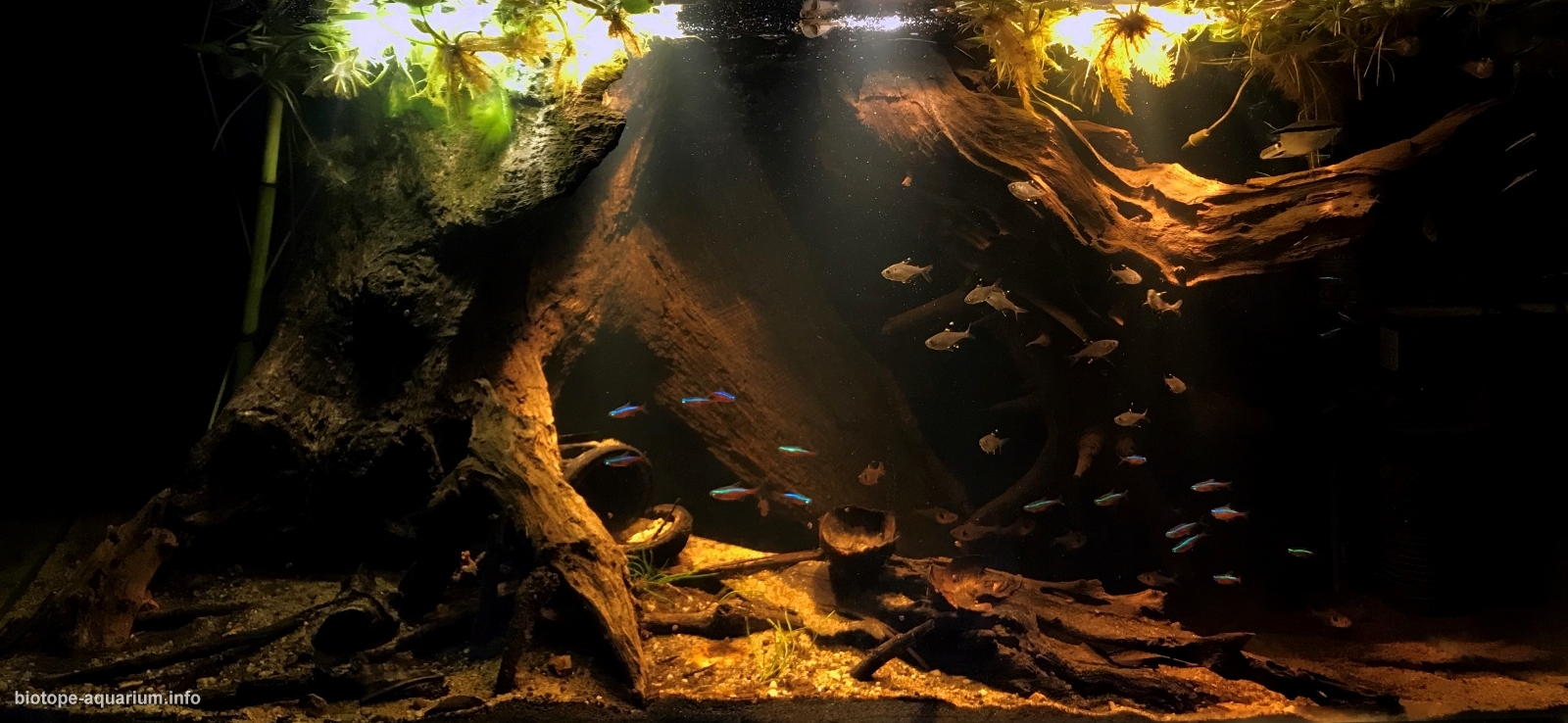Floresta de igapó
_th place in Biotope Aquarium Design Contest 2020

Volume: 160
Dimensions: 90x50x50
List of fishes: paracheirodon axelrodi, Pristella maxillaris, Hyphessobrycon sweglesi, nannostomus eques, carnegiella marthae, Otocinclus vittatus, Rineloricaria sp., mesonauta festivus(for a brief while)
List of plants: Limnobium Laevigatum, Aquatic grasses(a few sprigs here and there), Aquatic palm(roots of this can be submerged)
Description of decorations: Bogwood, Driftwood, palm twigs, pods of various trees and catappa leaf(crushed mostly).
Description of equipment: Filtration: Custom made – HOB filter, 1 pump for internal circulation and one for HOB, Lighting: Custom led setup combining 3000-6000k 37w + 24w 6500k Aquazonic LED Fixture
Water parameters: pH: ~6, TDS:~200PPM, Temp: 25-28degC, Ammonia 0ppm, Nitrites 0ppm
Additional info: 20-25% of water was changed twice a week.
INFORMATION ABOUT BIOTOPE
Description of the area surrounding the biotope: RIO Caures’ is a tributary that merges into the Rio Negros in the State of Barceloss, Brazil at 1°20’47.48″ S 63°11’30.35″ W. Though populated at the point where the tributary meets Rio Negro, but as the stream flows from the point of its origin, it goes through a heavily forested area, knows locally as ‘igarape de rio caures’. The tributary is seasonally rainfed and forms slower current catchment areas along the bank providing a vast habitat for a lot of fishes we know in the hobby.
Description of the underwater landscape of the biotope: Inspired by the flooded blackwater forests of Rio Caurés, aka the ‘igapó’ – Portuguese word for swamp forests that are seasonally inundated with freshwater. They create unique habitats for a diversity of small fish seeking shelter within these slow moving waters where debris and organic mater doesn’t wash away with current. This aquascape seeks to replicate such a habitat with the appropriate decor arranged in a way that defines the ecosystem. A layer of potting soil added at the base of left corner of the tank where the water palm was rooted, topped with a mix of gravelly substrate to hold the steep slopes at certain areas and also to avoid anaerobic conditions within substrate, this was topped with a mix of fine grade mixture of lighter colored sand mixed with crushed leaf debris. The giant piece of wood that is about 70lbs in weight(quite challenging to place in this tank) acts as a pivotal point where an interesting variation of substrate slopes and depths plays around it. The arch within the wood forms a narrow cave that opens right at the far left corner. Its quite interesting to see fishes shoaling in and disappearing down into the arch and emerging out from far left much higher than the point they were getting in. This is probably the longest time I had a biotope scape, started in november of 2018 and was taken apart a couple of months ago as I was moving my home. I had no intent to use it as a contest tank, but later as I was going through my gallery I could see a potential for this. The characins remained constant throughout the tanks lifecycle, but I had added a trio of festivums which later had to be moved out as they were about to outgrow this setup. Though the light was far from sufficient for photography, but the effect of sharp beams of light passing through the vegetation was something that mesmerized the viewers and the pictures cant justify the effect.
Description of the parameters of the habitat: Water ranges from clear flowing streams to acidic peat swamps. pH varies with the amount of dissolved organics in the area ranging from <4 – 6.5. Temparature throughout the year doesnt change much and stays steady around 81-86 F (27-30 C), TDS ranges from 5-200+.
List of fishes and invertebrates occurring in the nature biotope: Though there are 100s of species endemic to this region…a few fis from our hobby which we can relate to are:
Leporinus affinis, Corydoras aeneus, Pristella maxillaris, Hyphessobrycon sweglesi, nannostomus eques, carnegiella marthae, Otocinclus vittatus, Rineloricaria sp., mesonauta festivus, Uaru amphiacanthoides, Heros Efasciatus, Hemigrammus rhodostomus, Moenkhausia pittieri, Paracheirodon axelrodi, Paracheirodon simulans, Dicrossus filamentosus, Pygocentrus nattereri, Myloplus schomburgkii, assortment of eartheaters pikes and dwarf cichlids, etc..
List of plants found in the nature biotope: Aquatic Plantlist endemic to Upper courses of Rio negro – Cabomba furcata, Cabomba aquatica, Echinodorus tenellus, Ludwigia palustris, Echinodorus quadricostatus, Echinodorus amazonicus, Eleocharis vivipara, Staurogyne repens, Vallisneria americana, Myriophyllum aquaticum, Hydrocotyle leucocephala, Eleocharis acicularis, Limnobium laevigatum, Pistia stratiotes, Sagittaria subulata, Ceratophyllum demersum, Myriophyllum mattogrossense, Echinodorus bleheri. This along with a lot of seasonally submerged terrestrial trees, palms and bushes.
Threats to the ecology: The Site also contributes to the Amazon rainforest’s climate regulation on which the stability of the planet depends. The local communities are enormously ethnically and culturally diverse; the protected areas included in the Site aim to support their low-impact sustainable forms of resource utilization and agriculture. The Site directly or indirectly supplies water to at least six Brazilian municipalities, and the main river channel serves as a waterway connecting communities. Among the main threats to the Site are land conversion and clearance of vegetation, as well as hunting and fishing.
Sources of information:
- https://rainforests.mongabay.
com/0602.htm - https://www.semanticscholar.
org/paper/Black-water-forests- (igap%C3%B3)-vs.-white-water- forests-Myster/ b528435b55fa4f1e329f51b89ccddf bb36e559fb - https://www.scielo.br/scielo.
php?pid=S0044- 59672006000100005&script=sci_ arttext&tlng=en - https://tanninaquatics.com/
blogs/the-tint-1/flooding- your-own-rain-forest- simulating-an-igapo-in-your- aquarium
